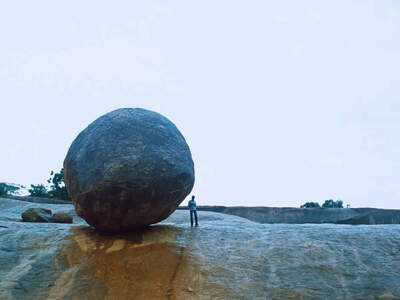Krishna's Butterball in South India which defies gravity and exists as a natural wonder

India is a country of beauty and unusual attractions. One such attraction in South India is a natural rock that has defied science (gravity) and baffled the world. Far from the eyes of commercial travellers is a natural wonder called Krishna’s Butterball in the old coastal town of Mahabalipuram (Mamallapuram), Tamil Nadu .
Also known as Krishna’s Butterball, this gigantic rock ball is set precariously on a tiny (read barely-existing) incline. This ball is basically a giant granite boulder which has been unmoved for over a thousand years now! The rock has defied gravity, logic, and scientists but has attracted curious travellers attempting to make it roll down. But then all have failed miserably (Lol).
So let’s try to figure out the mysterious balance and try to explore the legends around it.
Krishna’s Butterball: The legend behind it
You won’t need the address of this place as you’ll automatically be guided towards it, thanks to the moving crowd towards it. Krishna’s Butterball, or the granite rock looks like it will just drop or fall or tumble down the slope. The boulder, which is about 6 meters high and 5 meters wide, weighs approximately 250 tons. The rock rests on a base that’s barely 4 feet across and leans at a striking angle on a smooth, slippery slope, and is silently still. Shockingly, the rock has not budged even an inch through earthquakes, cyclones, or rains, a fact that makes it a research-worthy topic for all.

As far as legend is concerned, Hindu mythology narrates a story related to Lord Krishna. Little Krishna’s love for butter is not hidden from the world. He would often steal and hoard butterballs from his mother’s kitchen. Soon, locals started calling this massive rock “Krishna’s Butterball,” because they believe (think) Little Krishna dropped a large dollop of butter that fell from heaven on Earth.
There is another older Tamil name, Vaan Irai Kal, meaning “Stone of the Sky God.” The name shows how ancient locals saw the rock as a heavenly gift or divine symbol, mysteriously balancing itself beyond human understanding, defying gravity and science.
Scientists, geologists, and engineers have tried to explain this balance which is beyond anyone’s comprehension. Some think the rock’s base may have a deeper anchoring point hidden underground. Others think it's because natural weathering of the granite surface created a perfectly balanced contact point. No answer yet!
The historical story behind King Narasimhavarman I’s attempt

There’s a famous historical tale about Krishna’s Butterball from the Pallava dynasty. It’s believed that King Narasimhavarman I, the ruler who commissioned the magnificent rock-cut temples of Mahabalipuram in the 7th century, once attempted to move the boulder fearing it might roll down and harm someone. He bought in elephants, and everything that can move the rock, but it did not even shift half an inch.
Centuries later, another attempt was made by the British Governor of Madras, Arthur Havelock in 1908. He also tried with elephants. He brought in seven elephants who together tried moving the rock for safety reasons but failed again. And that’s when everyone in the town started believing the boulder was protected by the gods.
Geological wonder, photographer’s paradise and a picnic hub

Today, Krishna’s Butterball has become a picnic hub attracting curious travellers from all over. Photographers also visit in big numbers to capture the mysterious rock. Locals visit a cheerful playground and a photo paradise. Photographers come to capture its surreal appearance. In a lot of pictures on the Internet, you’ll see visitors posing with hands “holding” or “pushing” the rock.
Not many must be aware of the fact that the region surrounding the rock is part of the larger Mahabalipuram UNESCO World Heritage Site. The whole place is all about rock-cut temples and ancient caves.
Why it’s a unique attraction
 Defies Gravity
Defies Gravity: It’s not the first rock with such a unique feature. There are many natural formations in the world that challenge the laws of gravity. There are balanced rocks in the U.S. and Africa resting on wide bases.
A cultural landmark: The rock in Mahabalipuram is deeply intertwined into folklore, science and tourism, reflecting Tamil Nadu’s cultural side.
Photo op: The rock enjoys an unrealistic and unbelievable positioning that makes it one of the most photographed landmarks in South India. Sunrise and sunsets are considered the best time.
Best time to visit: November to February is considered the best time because the weather remains pleasant.
Entry: There’s no entry ticket.
How to reach

The nearest railway station is Chengalpattu (around 30 km away), and Chennai International Airport is the closest air hub. Mahabalipuram is located some 60 km from Chennai. It is a 90-minute drive via the scenic East Coast Road. Travellers can find local buses, taxis, and guided tours to reach here.
So whether you are a history lover, a photographer, or just an offbeat traveller, the rock of Mahabalipuram will definitely roll right into your memory.
 India is a country of beauty and unusual attractions. One such attraction in South India is a natural rock that has defied science (gravity) and baffled the world. Far from the eyes of commercial travellers is a natural wonder called Krishna’s Butterball in the old coastal town of Mahabalipuram (Mamallapuram), Tamil Nadu .
India is a country of beauty and unusual attractions. One such attraction in South India is a natural rock that has defied science (gravity) and baffled the world. Far from the eyes of commercial travellers is a natural wonder called Krishna’s Butterball in the old coastal town of Mahabalipuram (Mamallapuram), Tamil Nadu .




